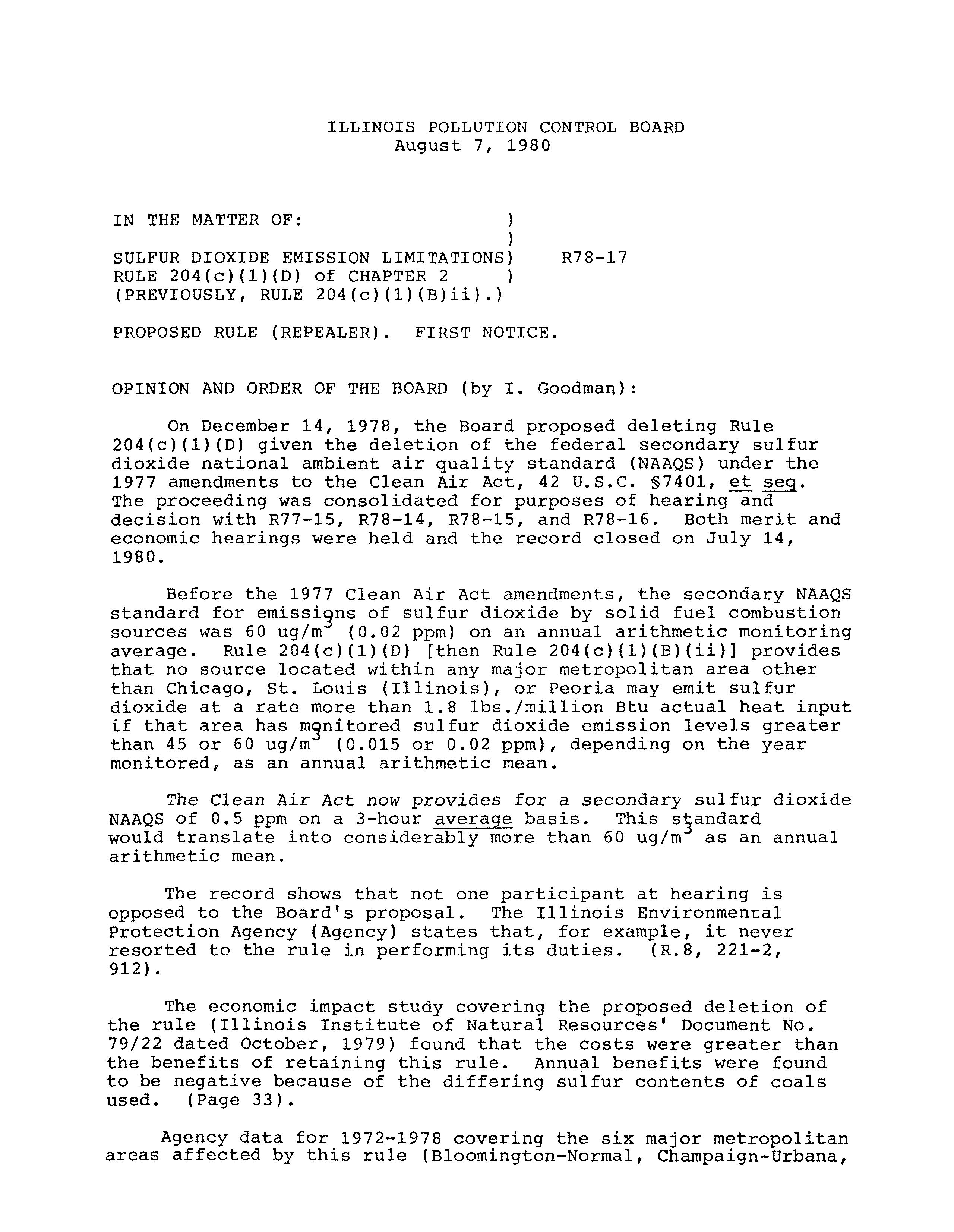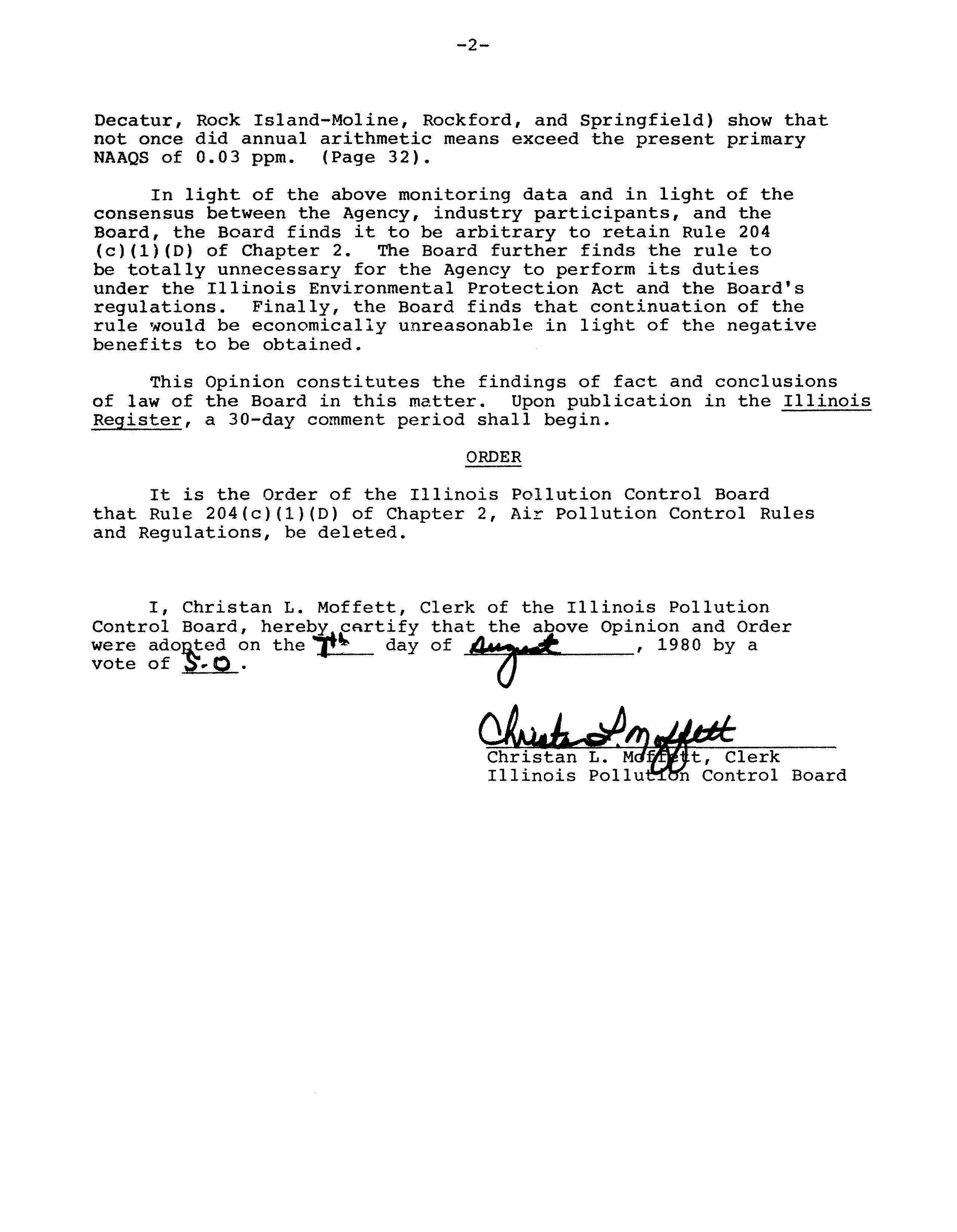ILLINOIS POLLUTION CONTROL BOARD
August
7,
1980
IN THE MATTER OF:
SULFUR DIOXIDE EMISSION LIMITATIONS)
R78—17
RULE 204(c)(1)(D) of CHAPTER
2
(PREVIOUSLY,
RULE 204(c) (1)(B)ii).)
PROPOSED RULE
(REPEALER).
FIRST NOTICE.
OPINION AND ORDER OF THE BOARD
(by
I.
Goodman):
On December 14,
1978, the Board proposed deleting Rule
204(c)(1)(D) given the deletion of the federal secondary sulfur
dioxide national ambient air quality standard (NAAQS) under the
1977 amendments
to the Clean Air Act,
42 U.S.C.
§7401,
et
~.
The proceeding was consolidated for purposes of hearing and
decision with R77—15,
R78—14,
R78—15, and R78—16.
Both merit and
economic hearings were held and the record closed on July 14,
1980.
Before the 1977 Clean Air Act amendments, the secondary NAAQS
standard for emissi~nsof sulfur dioxide by solid
fuel combustion
sources was
60 ug/m
(0.02 ppm)
on an annual arithmetic monitoring
average.
Rule 204(c)(1)(D)
then
Rule 204(c)(1)(B)(ii)
provides
that no source located within any major metropolitan area other
than Chicago,
St. Louis
(Illinois), or Peoria may emit sulfur
dioxide at
a rate more than 1.8 lbs./million Btu actual heat input
if that area has m~nitoredsulfur dioxide emission levels greater
than 45 or 60 ug/m
(0.015 or 0.02 ppm), depending on the year
monitored,
as an annual arithmetic mean.
The Clean Air Act now provides for a secondary sulfur dioxide
NAAQS of 0.5 ppm on a 3-hour average basis.
This s~andard
would translate into considerably more than 60 ug/m
as an annual
arithmetic mean.
The record shows that not one participant at hearing
is
opposed to the Board’s proposal.
The Illinois Environmental
Protection Agency (Agency)
states
that,
for example,
it never
resorted to the rule in performing its duties.
(R.8,
221-2,
912).
The economic impact study covering the proposed deletion of
the rule
(Illinois Institute of Natural Resources’
Document No.
79/22 dated October, 1979)
found that the costs were greater than
the benefits of retaining this rule.
Annual benefits were found
to be negative because of the differing sulfur contents of coals
used.
(Page 33).
Agency data for 1972—1978 covering the six major metropolitan
areas affected by this rule
(Bloomington—Normal,
Champaign-Urbana,
—2—
Decatur, Rock Island-Moline, Rockford, and Springfield) show that
not once did annual arithmetic means exceed the present primary
NAAQS of 0.03 ppm.
(Page 32).
In light of the above monitoring data and in light of the
consensus between the Agency,
industry participants, and the
Board, the Board finds it to be arbitrary to retain Rule 204
(c)(1)(D) of Chapter
2.
The Board further finds the rule to
be totally unnecessary for the Agency to perform its duties
under the Illinois Environmental Protection Act and the Board’s
regulations.
Finally,
the Board finds that continuation of the
rule would be economically unreasonable in light of the negative
benefits to be obtained.
This Opinion constitutes the
findings of fact and conclusions
of law of the Board in this matter.
Upon publication in the Illinois
Register, a 30-day comment period shall begin.
ORDER
It
is the Order of the Illinois Pollution Control Board
that Rule 204(c)(1)(D) of Chapter
2,
Air Pollution Control
Rules
and Regulations, be deleted.
I, Christan L. Moffett,
Clerk of the Illinois Pollution
Control Board, hereby cartify that the above Opinion and Order
were ado&ted on the
~
day of
4*~i.—
,
1980 by a
vote of
~
Christan L. Mdffl~t,Clerk
Illinois Pollut~b’nControl Board


